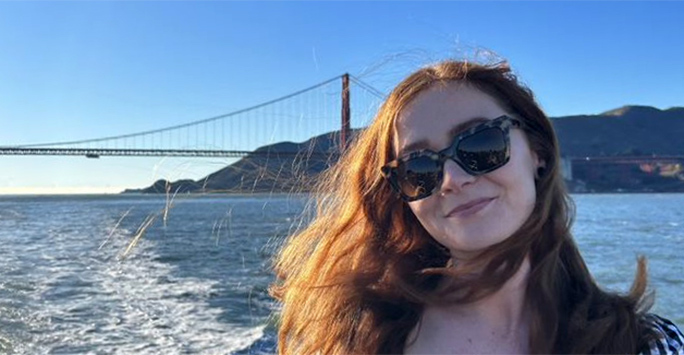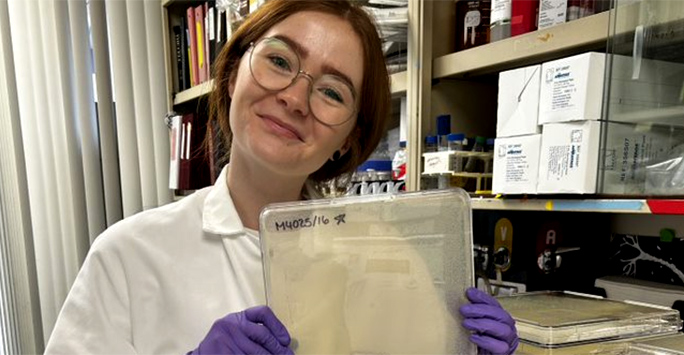
Dr Aisling Brady is a Postdoctoral Researcher in the Hinton Lab within the Department of Clinical Infection, Microbiology and Immunology. Aisling recently travelled to the US for a four-week research trip that involved learning new genetic techniques aimed at bolstering the ongoing battle against African Salmonella, known for its role in causing severe bloodstream infections.
Stanford collaboration
At the end of 2023, towards the end of my first year working at the University of Liverpool, I had the fantastic opportunity to visit Stanford University, California as part of an ongoing collaboration with Professor Denise Monack in the School of Medicine. I am thrilled to share some exciting details of my month-long expedition. It was an adventure filled with scientific discoveries, networking, and the joy of exploring the beauty that California has to offer.
The journey began with an invitation from Professor Monack, a collaborator whose recent work had caught our attention during the summer of 2023 at a Salmonella Gordon Research conference in Tuscany, Italy. Inspired by the ground-breaking research presented by Dr Benjamin X. Wang, we immediately engaged in discussions that paved the way for my visit to Stanford.
Learning new techniques
My primary goal for the trip was to delve into a cutting-edge technique known as Random Barcode Transposon Site Sequencing (RB-TnSeq). TnSeq has already contributed greatly to our understanding of Salmonella biology, however these methods are costly and relatively low-throughput. The innovative RB-TnSeq approach however is a high-throughput technique and promised to be a gamechanger in our study of African Salmonella. RB-TnSeq will enable us to study bacterial fitness across hundreds of conditions and may help us identify key genetic characteristics of Invasive Non-Typhoidal Salmonella (iNTS), which carries a significant disease burden across sub-Saharan Africa.

The collaboration with Professor Monack was an opportunity to understand the intricate mechanisms behind bloodstream infections caused by iNTS. RB-TnSeq, with its ability to map transposon insertion sites randomly throughout the bacterial genome, has emerged as a pivotal high-throughput tool to study gene function and essentiality. The information provided from such studies could potentially highlight novel inhibitory targets for developing therapeutics to target iNTS. Altogether, with expert guidance from Ben, we managed to successfully complete our work in generating mutant RB-TnSeq libraries in clinical iNTS strains. With this success, we now intend to continue using this technology back in our lab in Liverpool with the potential to pass the information along to other researchers interested in implementing the technique.
Outside the lab
Beyond the scientific pursuits, the trip was a truly enriching experience, with Stanford offering the perfect backdrop. The California weather, adorned with sunny days and gentle breezes, was a welcome break from the chilly Liverpool. The iconic palm trees lining the streets added a touch of charm to every stroll to the lab. San Francisco, a stone's throw away, was where I mostly spent my weekends. The city's vibrant culture, historic landmarks, and diverse dining experiences really captured my heart. From a boat trip to see the iconic Golden Gate Bridge to walking around the bustling streets of Fisherman's Wharf, every moment was a memory in the making.
However, what truly made this trip unforgettable was the warm embrace of the welcoming group in the Monack lab at Stanford. They not only shared their scientific expertise but also took great care of me outside the lab. Dinner trips became opportunities for cultural exchange, and a memorable hike through the Santa Cruz Mountains biological preserve really showed off some of the remarkable biotic diversity on the doorstep of the university.
Future plans
In conclusion, my visit to Stanford was a kaleidoscope of scientific exploration, cultural immersion, and personal connections. The journey left me invigorated, armed with new knowledge and techniques that will undoubtedly shape the future of our research on iNTS. As I bid farewell to California, I carry with me not only the progress made in the lab but also new friendships. Until next time, Stanford – thank you for the memories!